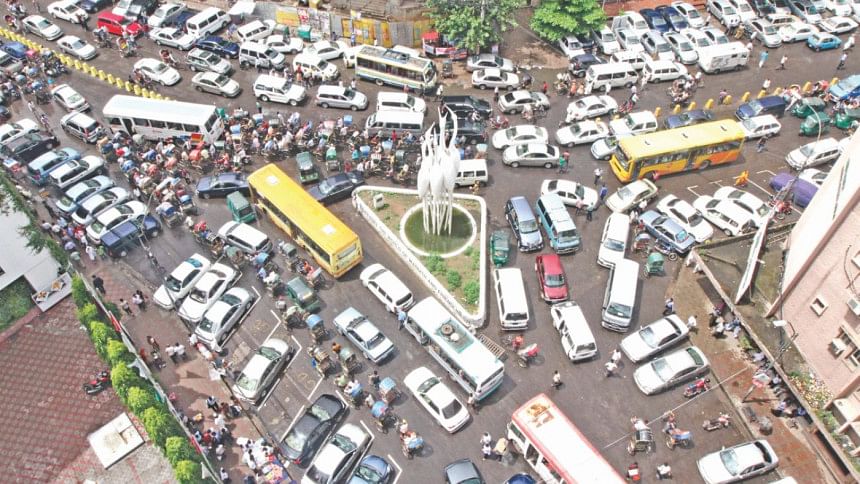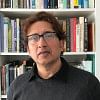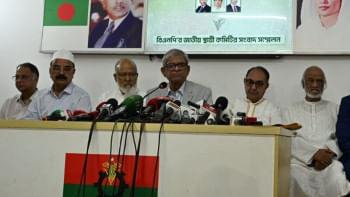Rethinking the roots of Dhaka's traffic congestion

Dhaka's road traffic has earned a dubious distinction. The New Republic, a prestigious American magazine, has recently dubbed Dhaka as the "traffic capital of the world."
My colleagues from different parts of the world, who have visited the capital city in recent times, talk about the city's paralyzing road traffic more than anything else. Many feel that the traffic gridlock here offers a vantage point to understand, broadly, the characteristic problems of urban governance in developing economies.
Most Dhakaites talk of traffic jam with both desperation and resignation. Some even post their turtle-paced mobility in real time on social media to express their helplessness. In the midst of widespread frustration, however, government agencies, experts, and amateurs alike present a variety of solutions, some of which are compelling. Meanwhile, more and more flyovers get built and elevated expressways are planned. Yet, traffic congestion continues to kill.
The biggest but often unstated obstacle to solving the traffic problem in Dhaka is the reckless belief that there is one grand technical solution out there. To propose a flyover or an elevated expressway or even mass transit as a cure-all solution to a vast urban pathology is to miss seeing its anthropological roots and, ultimately, its sustainable mitigation.
Consider this paradox. According to some sources, there are about 650 street intersections in Dhaka, but only 60 traffic lights. This is a gross asymmetry, and streets surely need more traffic lights. Yet, to believe that installing traffic lights would reduce street congestion dramatically is a false simplification of a complex urban dysfunctionality. People will not follow traffic light unless they accept it as the basic need of a functioning street. Yes, dedicated bus lines are cool ideas, but the young bus driver who migrated to the metropolis a few years ago from the rural heartland has no incentive to follow, nor knowledge of, basic traffic laws.
Zebra crossings won't matter if people don't walk on them. So, the crucial question is: How do we inspire people to respect the basic rules of the street? Most major metropolises of the world—such as, New York, London, and Paris—faced this question one way or the other at various stages of their respective urban evolution. This is the lesson learned: urban streets to function well would need certain city etiquettes to which all urbanites must subscribe as a basic social contract of workable urban living.
This is a huge challenge because we don't have a long urban history (only 7% urban population in 1971) and corresponding development of cosmopolitanism. Thus, in addition to providing technical solutions for the roads or developing sufficient street infrastructure, there needs to be a concerted social campaign to build a culture of abiding by urban laws. The reality is that this social transformation may need a generation or two before people would find value in the collective adherence to the rule of law.
Achieving that goal sooner would depend on how quickly we can revise an urban problem like street congestion in human terms. Technology is easy to fix. Human conditions aren't. The sooner we realize that Dhaka's traffic congestion is not a problem of transportation engineering alone the better. This is also a problem of culture. It is much more than a result of broken bureaucracy, inadequate infrastructure, and ad-hoc planning.
The first step to minimize the traffic crisis would be to combine the social awareness of an urban order with context-specific technical solutions. Developing social awareness itself warrants reorienting some of the prevalent urban thinking that blatantly promotes private automobile-centric planning. That is, provide more roads to accommodate more private cars, while the utility of mass transit remains an idealistic talking point. The share of private cars in Dhaka's daily commutes is a negligible 5-10 percent, but private cars occupy a staggeringly asymmetrical 70-80 percent of the road space.
The reason why public transportation isn't pursued with adequate urgency is the entrenched social glorification of private car ownership among the middle-class or aspiring middle-class. In a developing economy, the social value of car ownership can't be overestimated. Yes, the lack of security on the street and gender-unfriendliness makes cars an attractive refuge. Yet, let us not forget that cars are also the most recognizable icon of social mobility. It is the best way to flaunt your social status on the street. This deeply embedded middle-class sentiment still drives much of the country's transportation planning. There is very little evidence that the availability of public transportation would directly result in the reduction of private car ownership.
The effort to mitigate the traffic problem, thus, must address the anthropological roots of our middle-class values. There is a reason why nearly 8 million cars fill the roads of Delhi, and 1,200 more are added every day. Over 200 newly registered cars enter the city streets of Dhaka every day. Thus, more roads will not solve the problem because they are going to be filled with cars soon anyway. Our planning philosophy should focus on reducing the demand for cars rather than facilitating its unending supply. This is what sustainability gurus are advocating around the world these days.
The writer is an associate professor of architecture and planning at the Catholic University of America in Washington, DC, and the author of Impossible Heights (2015) and Oculus: A Decade of Insights into Bangladeshi Affairs (2012).

 For all latest news, follow The Daily Star's Google News channel.
For all latest news, follow The Daily Star's Google News channel. 



Comments